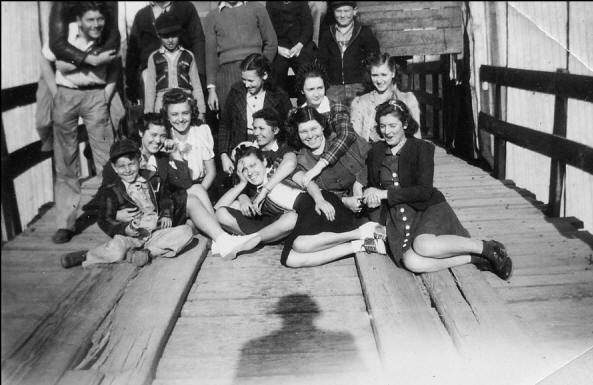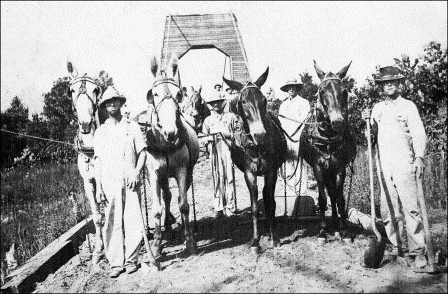

--Photo courtesy of Valeta Joyner Young
The bus riders relax on the swinging bridge at Little Red in 1941. Shown seated at left is L.E. Siler. Behind him (from left) are Faye Lindsey and Bonnie Rea Capps; lying down in front are Ne’ell Meacham and Wanda Lindsey. The two behind Ne’ell are Zula Pinegar and Valeta Joyner. Seated on the back row are Beverly Martin, Lena Capps and Ruby Nell Capps. Standing are W.H. Capps, unknown and Billy Martin.

By VALETA JOYNER YOUNG
In northern White County in 1939 there were students graduating from eighth grade who had little opportunity to attend high school. Because of the distance from our rural farm homes to the high schools in Pangburn and Pleasant Plains, continuing our education seemed almost impossible. There were no school bus routes and no family vehicles to take us. Our farm was a half-mile west of Holly Springs School. My parents owned the land for 55 years. Both high schools were about 10 miles away, but we had no choice. If we went, it would be to Pangburn. In the school year 1938-39 a young man named "Bunk" Caruthers started a bus route to Pangburn High School. His "bus" was a large cattle truck with high solid sideboards. But we were happy to ride it, and there was no charge. Across the middle of the sideboards a pole was nailed to give a pitched top. A tarp was stretched over the pole and the tarp was nailed around the sideboards. It was dark and hot on warm days, and cold and windy later in the year. At the rear a door was made. Below the door was a step to get into the bus. It was like riding to school in a tent. Near the middle of the school term the bus service began to unravel. Sometimes the truck would stall or get stuck in the mud due to poor road conditions. On the days when this happened we would have to walk the rest of the way home. To our great disappointment, "Bunk" became discouraged and discontinued the route. Most of the students simply stopped going to high school. There were five of us who boarded with families to finish the school year. I stayed with Everett and Pauline Edwards. My roommate was Margaret

Tharp. The Edwards family was very nice to us. At the beginning of the 1939-40 school term the picture got brighter. Harry Capps from the Steprock area started a "bus" service to Pangburn High School. The Capps truck-turned-bus was newer than the previous bus, so there were no breakdowns. Mr. Capps was very prompt and dependable. He was also an excellent driver. The bus route started in the Steprock-Sunnydale community and continued up to Holly Springs and Roosevelt to pick up students. There were about 30 of us in all. I lived off the route, so I walked a half-mile to the bus route. I had to be at Holly Springs School by 7 a.m. The bus also picked up students in Little Red, Dewey and Grubtown. Riders I remember were Eudora Adams, Helen and Shelby Ramsey and Leo, Leon and Lloyd Steward. The bus had to cross the Little Red River on the old swinging bridge. Some folks feared (with cause, as it turned out) that the bus and students were too heavy and the bridge would fall into the river. When we came to the bridge we got off the bus and walked across. Then Mr. Capps would drive the bus over the bridge, and we would then get back on board to continue on our way home. Five of us who rode the bus graduated in April 1941. We were Averil King, Ne’ell Meacham, J.A. Wiggs, Boyce Martin Jr. and I. Sometimes the Pangburn kids would refer to us as "the kids across the river." The inside of the Capps bus was the same as the Caruthers bus – three long benches, one on each side and one in the middle. Those of us who were picked up first usually had a better choice of where we sat. This era did not have backpacks or hot lunches. We sat and held our books and lunches on our laps. As we sat on those long benches every one was talking – about a mixture of subjects. We were lucky that we lived through that noise without a hearing problem. Can you imagine 20 to 30 teenagers talking at once? Everyone got along and there wasn’t a bully in the group. We made the trip in all kinds of weather. It wasn’t a plush comfortable ride but we had many laughs and smiles. I liked high school and learned more about literature and social studies. The high school diploma and typing classes helped me get a job as a clerk-typist. The class of 1941 was the last to attend Pangburn High School from our area. In 1941-42, Charlie Meacham had a truck/bus route to Pleasant Plains High School. The Steprock, Sunnydale, Holly Springs and Roosevelt students transferred there. Several of those school bus kids are gone now. And the old swinging bridge did collapse, killing two people, a few years later when a family car attempted to cross it. Riding the cattle truck turned-into-a-school bus was an experience I will never forget. I was and still am glad that I stayed the course to get my high school diploma. vvv
(The writer is a member of the White County Historical Society who lives in Lodi, CA.)